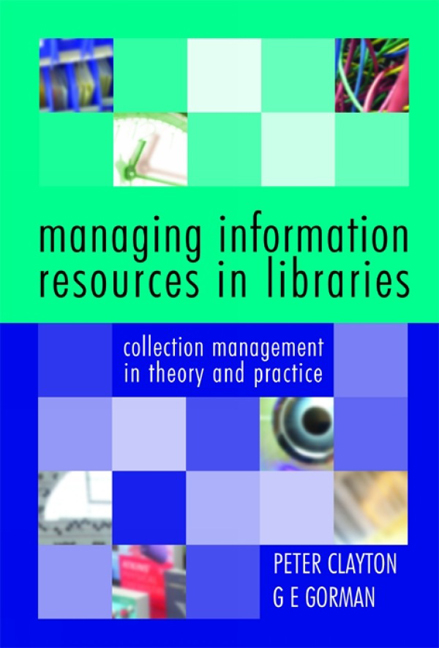Book contents
- Frontmatter
- Contents
- About the authors
- Preface
- 1 Managing information resources in context
- 2 Collection management and collection development policies
- 3 Conspectus
- 4 Resource sharing and co-operative collection development
- 5 Selection: policies and procedures
- 6 Selection resources
- 7 Acquisitions processes and procedures
- 8 Budget management
- 9 Collection evaluation and review
- 10 Preservation and weeding
- The literature of collection management Adela Clayton
- Index
10 - Preservation and weeding
Published online by Cambridge University Press: 08 June 2018
- Frontmatter
- Contents
- About the authors
- Preface
- 1 Managing information resources in context
- 2 Collection management and collection development policies
- 3 Conspectus
- 4 Resource sharing and co-operative collection development
- 5 Selection: policies and procedures
- 6 Selection resources
- 7 Acquisitions processes and procedures
- 8 Budget management
- 9 Collection evaluation and review
- 10 Preservation and weeding
- The literature of collection management Adela Clayton
- Index
Summary
Focus questions
• What environmental conditions are appropriate to facilitate the long-term preservation of library resources?
• What strategies have libraries adopted to ensure increased usage of materials does not place them at increased risk of damage?
• How might digital materials be preserved?
• Why is disaster planning important, and how might it be undertaken?
• What is the generally accepted basis of weeding?
• How might one go about deciding which serials to cancel?
• Should electronic media also be considered for weeding?
It may seem strange to deal consider together both preservation, arranging for the long term retention of information sources, and weeding. Are not these alternatives? However, both deal with decisions about the long-term value of materials: is this an item which we will always require? Or is it something which was acquired to meet a specific need, now past?
These two areas thus share a common core of professional decision making about the value of materials. Unfortunately, this in turn means they also share a common problem with the cost in terms of staff time of undertaking these activities. Weeding, in particular, can be daunting for librarians whose whole professional ethos is to gather, rather than discard – and at the end of it, what do you have? Only a few spaces on shelves, quickly filled. For this reason, too many libraries find it easier to leave materials, once acquired, generally available. The longer-term effect of this neglect is that material of continuing value may not be adequately protected, while a mass of items of little or no enduring value crowd the library's shelves and catalogues, making it harder to find current material. The library ends up looking like a bibliographic scrapheap.
Both preservation and weeding come at the end of the library information life cycle (see Figure 10.1). They are the final processes involved in managing information resources in libraries.
One of the core functions of libraries is to preserve real access to the documentary record. This is an activity that will give them, in common with archives, an enduring role in the wired world of the 21st century.
- Type
- Chapter
- Information
- Managing Information Resources in LibrariesCollection Management in Theory and Practice, pp. 187 - 214Publisher: FacetPrint publication year: 2006



